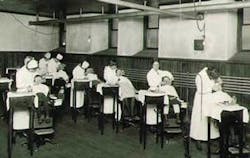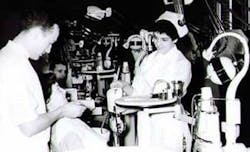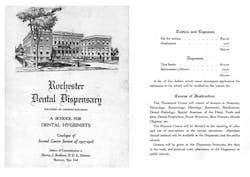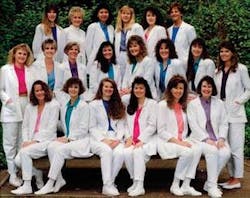All in the Family
by Catherine Draper, RDH, MS
Dental hygiene through the generations
Last summer, on my way to the ADHA Annual Session in Orlando, I was catching up on my dental hygiene journal reading while waiting for my red-eye flight. As I closed my magazine in preparation for boarding, the woman sitting opposite me asked, “Are you a hygienist?” When I answered yes, she replied, “Well, so am I!” Although we were on the same flight east, she was actually heading to New York to visit her family, and our meeting in the airport was pure coincidence. As we began to chat about dental hygiene, she shared that she had been practicing for more than 40 years and that the profession had been a great choice for her. In fact, she said that dental hygiene had also been a great choice for her mother who was now in her 90s, and her daughter who was in her 40s.
I had heard of mothers and daughters or sisters in the profession, but this was the first time I had met anyone with three generations in dental hygiene in one family. We separated once we boarded our flight, but I kept thinking about what she had said about how much satisfaction both she and her daughter had gotten from their careers as dental hygienists and how her mother still enjoyed hearing about what was happening in the profession. I was particularly touched by her comments on how good the dental hygiene profession had been to her and the fact that she continued to enjoy her work, even now as she was approaching retirement. After the flight, we exchanged contact information and promised to be in touch.
I kept thinking about the changes within our profession over the years and the fulfillment we all strive for as health-care providers. I thought it would be interesting to look at some of the differences and similarities in what makes dental hygiene a rewarding career across three generations. Once I returned home, I received an e-mail from the daughter of my airport friend. As it turned out, we live in the same city and she belongs to my dental hygiene component. She, too, was interested in telling her family’s story, especially with her grandmother getting older. Last fall, I spent an afternoon with Rowena Wood and her daughter, Stacey Steffens, so they could share their story of three generations of dental hygienists.
Rowena Kendall Wood graduated in 1933 from the Eastman Dental Dispensary School for Dental Hygiene, in Rochester, N.Y. At that time, the Eastman School for Dental Hygiene was part of the University of Rochester, and the dental hygiene program was one year in length. Encouraged to become a dental hygienist by her dentist brother, Ralph, Mrs. Wood had to wait a year after graduating from high school before entering the program because she needed to be 18 to apply for her final examination for licensure.
Upon completion of the program, she also attended two summer sessions to get her teaching certificate. Tuition for the dental hygiene program at Eastman was $200 in 1932, and there were 50 students in Mrs. Wood’s class. She still remembers the personal supervision and excellent instruction she received from the faculty, especially from the program director, a female dentist named Dr. Ruth Vann. She also recalls that the Dispensary’s benefactor and founder, George Eastman, was a frequent visitor to the dental hygiene clinic. She had the pleasure of meeting this kind man personally on several occasions.
When asked what she liked least during her dental hygiene education, Mrs. Wood remembers the pediatric tonsillectomy cases at the Dispensary. At that time, children would come to the clinic to have their tonsils and adenoids removed by the oral surgeons as outpatients. The dental hygiene students were responsible for postoperative patient care, and the children would often be quite sick after surgery. It is hard to imagine having one’s tonsils removed in the dental office or clinic today! Mrs. Wood also remembers the firm rule of “never wearing one’s uniform on the street,” a very responsible infection-control practice.
After graduation, Mrs. Wood worked as a school hygienist. In those early days, the hygienist practiced standing up using a foot treadle to power the handpiece to polish. Later, after her children were older, she worked in private practice.
Power-driven equipment, improved home-care options, and better dental hygiene education are the most significant changes that Mrs. Wood has seen in the last 75 years. Although officially retired in 1970, she continues to be interested in dental hygiene, keeping up with the profession by reading dental hygiene publications and sharing new information with her daughter and granddaughter. She was especially thrilled when her granddaughter became a dental hygienist. According to Mrs. Wood, “Dental hygiene is the best profession!”
Rowena Joy Wood graduated from the Eastman Dental Dispensary School for Dental Hygiene in 1963, with an Associate Certificate in Dental Hygiene. The program had expanded to two years in length since her mother had graduated 30 years earlier, and Rowena was able to begin her studies when she was 17. She says that her mother was her role model for becoming a dental hygienist, but there were other reasons that influenced her choice. The relatively short (two-year) program plus the flexibility of employment options and the demand for hygienists factored into her decision as well. There were 38 students in her class and most of them lived on campus under close supervision in the college dorms. The dental hygiene students also had a strict dress code that included starched white dresses and white caps. Uniforms were never worn on the street. The students often treated schoolchildren in makeshift clinics set up in hallways, or employees at the local Kodak factories. Instruments were sterilized in boiling water rather than in an autoclave.
Rowena said her least favorite aspect of the program was the tooth-carving project for dental anatomy. Selected anterior and posterior teeth had to be carved to scale from Ivory soap. The finished teeth were supposed to reinforce anatomical features of each tooth, an exercise that has, thankfully for many students, been dropped from most dental hygiene programs. I have to say, though, the carvings she showed me when we met were perfect replicas of real teeth. They were far better than my attempts in wax (which did not need to be carved to scale) when I was a student.
The class of 1963 was the second group of students to take the newly created National Board Dental Hygiene Examination. The test covered a total of 12 subjects that were grouped together into a four-part exam with 400 multiple-choice questions. Rowena remembers making the newspaper with the high score she received on the National Board. When I asked her what she liked the most about her dental hygiene education, she said the lifelong friendships she has maintained with many of her classmates. She still gets together with her former classmates at various alumni programs sponsored through the Eastman Center at the University of Rochester.
For the last 33 years, Rowena has practiced dental hygiene in California, working in general practice settings. Nowadays, she is happy to be able to administer local anesthetics when needed and she uses ultrasonic instrumentation to access and debride deep pockets. She likes the new instruments with ergonomically designed handles that have replaced the old, skinny handles and single-ended instruments. When she first began to practice in California in the early 1970s, she saw a patient every half hour. In her current practice, where she has worked for the last 15 years, she sees patients on a 50- to 60-minute schedule. (It makes you wonder what we were able to do in those 30-minute appointments!)
Rowena says that the most significant changes she has seen in dental hygiene have come in the areas of ergonomics for increased working comfort, the many options available for improved pain control, and the use of implants for single- and/or multiple-tooth replacements. When I asked what the most rewarding aspect of the dental hygiene profession has been, she said, “I have had the opportunity to work with some wonderful people who are interested in helping people achieve health, rather than just make a million dollars.”
Stacey Steffens graduated from Cabrillo College in Aptos, Calif., in 1992 - 59 years after her grandmother - with an Associate of Science degree in dental hygiene. Unlike her mother and grandmother though, she did not decide that she wanted to become a dental hygienist while she was still in high school. In fact, she was married and had just given birth to her daughter when she decided that she wanted to switch from studying business and begin taking prerequisites for the dental hygiene program at the local community college in her home state of California. Stacey says that it was the influence of her grandmother and mother that made her take a second look at dental hygiene. Once she had decided on dental hygiene as her future career, her mother and husband helped with child care so that she could attend school. Two years later, at age 25, Stacey was accepted into the dental hygiene program at Cabrillo College. Her daughter was an active 2-year-old at the beginning of the program as Stacey worked to juggle the demands of school and family life. This was quite a different experience compared to that of her grandmother, who lived in a private home and did light chores to earn her room and board while studying dental hygiene!
Like her mother, Stacey’s fondest memories of dental hygiene school revolve around the lifelong friendships she has had with her classmates. Her class continues to keep in touch regularly via e-mail and is in the process of planning its 15-year reunion. Although she didn’t have to deal with the dreaded Ivory soap tooth carvings, Stacey says that what she liked least about dental hygiene school was the constant stress she felt with exams, performance tests, and National and State Boards. (It was especially stressful to perform to her full potential considering her mother’s stellar performance on the National Board!) The National Board that was administered in 1992 still had 400 multiple-choice questions, but the format had changed to two sections: one covering the “Scientific Basis for the Practice of Dental Hygiene” and the second, larger section covering the “Provision of Clinical Dental Hygiene Services.” Anyone who has taken the National Board since 1998 has experienced yet another format to add to this stress-inducing experience. The current format consists of approximately 350 multiple-choice questions with two components - scientific discipline-based questions and questions based on hypothetical patient cases. The dental hygiene body of knowledge has certainly grown since Grandma Rowena’s student days!
Stacey has worked four days a week for the last 14 years in a general and cosmetic dental practice in Los Gatos, Calif. She sees eight patients a day and has one-hour appointments. She says she uses many of the same instruments she used during her student days, but says the handle designs just “keep getting better all the time” for improved ergonomics. The biggest changes she has seen in her practice have been in the area of digital radiography and the introduction of the CEREC computer-generated porcelain crown restorations as treatment options. Another recent change for Stacey came when she accepted a part-time clinical faculty position at Western Career College’s new San Jose campus. She says she has really enjoyed the opportunity to work with students in clinic and share her clinical skills and expertise. She has also mentored two of her former classmates to pursue clinical faculty positions at Western Career College. She is now looking into courses to enhance her teaching skills.
At the end of our lunch together, I asked Stacey if she has encouraged her daughter Heather, who is currently studying business at California State University in Long Beach, to consider a career in dental hygiene. She said most emphatically, “Yes! Dental hygiene is such a great and rewarding career. You can work part time or full time. There is potential for growth in so many areas within dental hygiene - teaching, public speaking, marketing, and public health. The opportunities are endless!”
Grandma Rowena should be very proud of the example that she set back in 1933!
Author’s note: Rowena Kendall Wood passed away on January 19, 2007, at the age of 92. Although she did not live to see the printed copy of her family’s story, she derived great pleasure and renewed many fond memories while reading the draft of this article.
The Eastman Dental Dispensary School for Dental Hygienists
and the University of Rochester Eastman Dental Center
and the University of Rochester Eastman Dental Center
Rowena Kendall Wood and her daughter, Rowena Joy Wood, were both graduates of the Eastman Dental Dispensary School for Dental Hygienists in Rochester, N.Y. The Eastman School offered one of the first programs for dental hygienists in the United States, with the first class graduating in 1917. The Fones School in Bridgeport, Conn., graduated its first class three years earlier in 1914. Originally called the Rochester Dental Dispensary, the clinic was built with funds donated by George Eastman, philanthropist and inventor of photographic film. The city of Rochester had opened the first free dental clinic in the United States in 1892, but it had been forced to close several years later due to lack of funding. The new dispensary opened with 37 units in 1917. The Rochester Dispensary was a prime example of early 20th century philanthropy from wealthy industrialists designed to improve the living conditions of those less fortunate. William Bausch and Henry Lomb of the Bausch and Lomb Optical Company also made large donations to support the clinic.
In a letter to the Trustees of the Dispensary in 1920, Eastman wrote, “The main object in mind when the Dispensary was founded was the care of teeth of children in Rochester and its vicinity ... I did not foresee that it might have an opportunity to become a part of a greater project for a higher grade of dental education than had before been attempted.”
The Rochester Dispensary soon became a center for postgraduate dental education, research, and dental hygiene education as well as patient care. By 1930, Eastman had funded dental clinics and institutes in London, Brussels, Stockholm, Rome, and Paris.
The School for Dental Hygienists of the Eastman Dental Dispensary ran from 1917 until 1964. Class sizes ranged anywhere from 30 to 70 students over 57 years. In 1964, Monroe Community College in Rochester took over the administration of the program and the school moved to the Monroe campus. Currently, an average of 30 to 40 students graduate each year from Monroe’s dental hygiene program with an Associate of Science degree.
The original brick Italian Renaissance style building was vacated in 1978 when the renamed Eastman Dental Center moved to new buildings adjacent to the University of Rochester Medical Center. In 1996, The Eastman Dental Center and the University of Rochester merged to become partners in the provision of oral health care, graduate education, and research. The Eastman Dental Center has retained the original vision of its benefactor, George Eastman, by emphasizing prevention and community service in care of the underserved in the postgraduate dental programs at the University of Rochester Medical Center.
The original Rochester Dental Dispensary has been empty for almost 30 years. Although the building is listed in the National Register of Historic Places and is a designated local landmark, property owners in the late 1990s wanted to have the building demolished to make way for a big box store and a fast food restaurant. The local preservation commission denied the permit. Unfortunately, the building remains threatened with “demolition through neglect.” Architectural studies show that the building can be effectively rehabilitated, but a new owner or developer needs to be found to protect the Eastman Dental Dispensary from demolition. The Landmark Society of Western New York continues to advocate its protection while actively seeking a buyer. But the building remains in peril. To learn more about the history of the Eastman Dental Dispensary, visit the Basil B. Bibby Library on the Internet at www.urmc.rochester.edu/Dentistry/Bibby/.
Catherine Draper, RDH, MS, has been a dental hygienist for more than 30 years. She is a past president of the California Dental Hygienists’ Association and was the 2001 leader of the People to People Delegation of Dental Hygienists to China. Cathy is a 2005 recipient of the Sunstar/Butler RDH Award of Distinction. She currently works in private practice in Mountain View, Calif., and is also a member of the adjunct faculty at Foothill College in Los Altos Hills. In addition to being an active member of CDHA and ADHA, she has been a library reference associate, helping patients and their families access health information at the Stanford Health Library for more than 10 years. Cathy may be contacted at [email protected].






